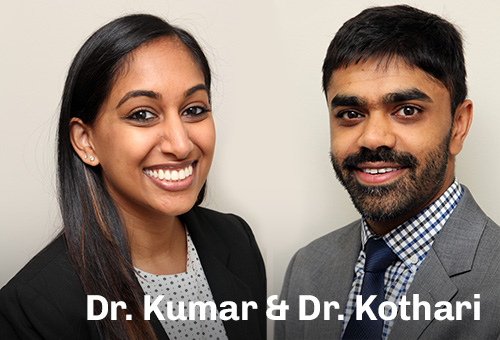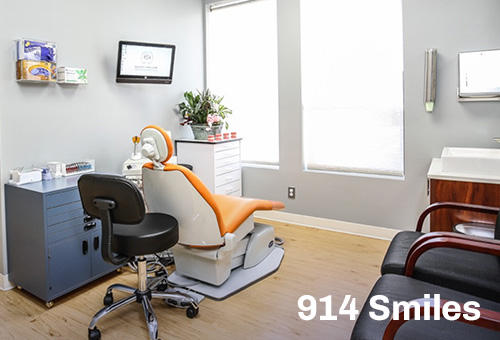
Do I need braces? This is a question we hear a lot at our practice. Dr. Rishi Kothari and the team at 914 Smiles help patients from Tarrytown, Sleepy Hollow, Hawthorne, Pleasantville NY, and the surrounding area learn about their orthodontic treatment options. While the only way to determine if you do need braces is to schedule a complimentary consultation so that Dr. Kothari can perform an exam and evaluate your diagnostic records, there are a number of reasons that could point to you being a good candidate.
In this post, we’ll cover:
- What are braces?
- What happens when I get braces put on?
- How do braces work to straighten teeth?
- What different types of braces are offered at 914 Smiles?
- What are the benefits of braces?
- Do I need braces?
- When should I get braces?
- How much do braces cost?
What are braces?
Braces are a teeth-straightening system comprised of brackets and archwires. The brackets are bonded to the teeth using a special adhesive. This means braces are a fixed orthodontic appliance, and they stay in place throughout your entire treatment.
What happens when I get braces put on?
After a thorough examination, Dr. Kothari will determine your diagnosis and identify the ideal position for each individual tooth in your mouth in order to give you straight teeth and an aligned, functional bite. Once he creates a personalized braces treatment plan, you’ll come in for your bonding appointment.
Does getting braces hurt? Nope. Not at all. Getting braces put on is painless and no needles are involved. At your bonding appointment, we’ll clean your teeth, use a cheek retractor to gently keep your cheeks out of the way and then dry your pearly whites. Dr. Kothari will stick either metal or ceramic braces brackets onto the front surfaces of your teeth. He’ll thread archwires through the brackets.
While the process of getting braces put on doesn’t hurt, your teeth can be a little bit tender during your first week with braces, as well as for a day or two after adjustments. This just means your braces are working!
How do braces work to straighten teeth?
Your braces brackets serve as an anchor, while the archwires act as tracks, exerting pressure and guiding the teeth into place. This continuous pressure causes the bone and tissues to break down, allowing the teeth to move into the desired positions throughout the course of treatment. New bone and tissue eventually forms around the teeth in their new places and secures them in the jawbone.
Your braces straighten the teeth in each arch independently of one another. If your bite (the way the upper and lower teeth meet) is also misaligned, auxiliaries like braces rubber bands may be necessary. Rubber bands provide the connective forces to bring the arches together properly.
What different types of braces do you offer 914 Smiles?
At 914 Smiles, we offer several types of braces, including:
- Metal Braces – Traditional metal braces are what comes to mind when most people hear the word “braces.” The metal braces we use are made from a space-age metal alloy, which makes them extremely lightweight and slim. So, no, you won’t have the stereotypical mouth full of metal! They’re more attractive, comfortable and effective than ever before. Patients can even enhance them with colorful elastics making these the most popular option when it comes to braces for kids or younger teens.
- Clear Ceramic Braces – Adult and teenage patients tend to love our clear ceramic braces. The clear braces are made from a translucent ceramic material that blends in with your smile. Clear braces are less noticeable than metal ones. Our clear braces brackets are stain-resistant and small, smooth and rounded, making them comfortable and discreet.
- Clear Aligners – While this post is about braces, if you’d prefer a removable, virtually invisible treatment option, Dr. Kothari is a leading Tarrytown Invisalign® and 3M™ Clarity™ Aligners provider. Thanks to our 3D printer, he also offers 914 Aligners, our own, in-house brand.
What are the benefits of braces?
The long-term goal of braces is to give you a set of perfectly straight teeth. Correctly positioned teeth make brushing and flossing easier and more effective, which reduces your risk of tooth decay and gum disease.
Properly aligned teeth and jaws also work more efficiently. When your teeth and jaw are in the ideal positions, you can chew, speak and even breathe properly.
Additionally, aligning the teeth and jaw wards off the uneven wear of enamel, and jaw and TMJ pain, as well as the associated headaches and neck aches. Last, but not least, one of the biggest benefits of braces is that you’ll get a beautiful smile and the confidence and self-esteem that comes with it!
Do I need braces?
Braces are an effective treatment option for even the most serious cases of malocclusion (improper bite). They can work to turn teeth or shift them forward, backwards, upwards or downwards from the jaw. Braces are an excellent tool for correcting:
- Overjet – When the front top teeth stick out too far in front of the bottom teeth, it’s known as having excess overjet. Braces to correct overjet are a great option!
- Open bite – An open bite is when the top and bottom teeth don’t meet at all and there is an opening, or space, between the arches when the jaw is closed. We can use braces to fix an open bite.
- Crossbite – A crossbite is when some of the bottom teeth bite in front of some of the top teeth. Patients can have a posterior crossbite (crossbite of the back teeth) or anterior crossbite (crossbite front teeth). Getting braces for a crossbite, depending on the severity and the type of crossbite, is usually the most effective solution.
- Underbite – An underbite is when the bottom teeth are in front of the top teeth when the mouth is closed. Since an underbite is often skeletal in nature, early intervention can make a huge difference and help fix the problem without surgery. When we use braces for an underbite, other appliances may also be necessary.
- Overbite (deep bite) – An excessive overbite, or deep bite, is when the top teeth overlap the bottom teeth to a large degree. If you have an overbite, braces, typically along with rubber bands, can help to straighten the teeth and align the bite.
- Spacing – When there is too much room in the jaw, gaps, or spaces, can form between the teeth. Getting braces for gaps between the teeth will close the spaces and give you a properly aligned smile.
- Crowding – Crowding occurs when there isn’t enough room in the jaw to accommodate all of the teeth. To squeeze in, teeth might overlap, shift forward or back or rotate. Braces can fix crowded, crooked teeth.
If you have one of the above concerns or you’re just generally unhappy with the appearance of your smile, you’re probably a candidate for braces.
While we can straighten teeth without braces using clear aligners, including Invisalign, 3M Clarity Aligners and our own, in-house 914 Aligners, it depends on your case and some patients just prefer braces.
When comparing clear aligners vs. braces, removability is something to consider. If you’re someone who loses things easily and you worry you won’t be able to keep track of clear aligners, you might like that braces are bonded to the teeth.
When should I get braces?
A patient’s age, the severity of the malocclusion, and the cost of treatment are important considerations when thinking about orthodontic treatment with braces.
It’s recommended that children have their first orthodontic evaluation by the age of 7. At this point, Dr. Kothari can assess their growth and development, see how their bite is shaping up and identify problems like severe crowding, a crossbite or an underbite that could require early intervention.
We know, a lot of parents ask, “Is it worth it to buy my kid braces at a younger age?” In certain cases, intervening early with phase 1 orthodontic treatment while a child is still growing and has some of their baby teeth can ward off more serious problems that would require surgery, extractions or lengthy treatment later in life. Depending on the child, their diagnosis and needs, we could use braces for kids or other appliances to guide jaw and facial growth and make room for the permanent teeth to erupt into their ideal positions.
Since we treat children conservatively and only recommend phase 1 braces or appliances when there are clear, health-based reasons for it, most of the time, the first visit will kick-off an observational period. Dr. Kothari will monitor your child over the years and let you know when the time is right to start braces treatment, typically once all of the permanent teeth (aside from the wisdom teeth) are in at around the age of 12.
However, there is no age limit to braces and braces for adults are effective. As long as your teeth and gums are healthy, we can straighten your teeth even in your senior years.
How much do braces cost?
After asking if they need braces, the next question we get from patients is, how much do braces cost? At some practices, the Invisalign, Clarity Aligners and clear braces cost is higher than the cost of traditional metal braces. At 914 Smiles, we strive to make braces affordable for all of our patients, which is why we offer clear aligners, clear braces and metal braces all for the same price.
We can also file with your dental insurance if your plan offers orthodontic coverage. If you don’t have insurance or it doesn’t cover braces, consider our 914 Smiles Club. This in-house dental discount plan is a yearly membership program that not only offers savings on orthodontic treatment, including braces, but also guarantees a full range of preventative care, such as exams, digital x-rays, fluoride treatments and cleanings with our pediatric dentist, all for a low cost. The best part? There are no deductibles, no yearly maximums and no exclusions for elective procedures.
Additionally, we offer competitive payment plans, including in-office, interest-free financing. This will allow you to break up your braces cost into affordable monthly payments. At your initial consultation, a team member will go over the cost of treatment and work with you to find a financing plan that meets your needs and budget.
Connect With Dr. Kothari Today!
If you have any questions about clear aligners, metal braces or clear braces in Pleasantville, Tarrytown, Sleepy Hollow, Hawthorne or Briarcliff, NY, or you’re ready to get straight teeth and a healthy smile, schedule a complimentary consultation with Dr. Kothari. Contact 914 Smiles to book your appointment today!



